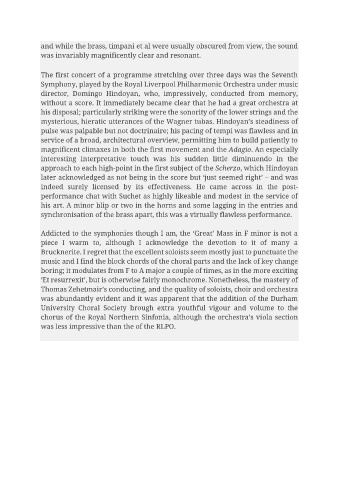Page 227 - Royal Liverpool Philharmonic Coverage Book 2023-24
P. 227
and while the brass, timpani et al were usually obscured from view, the sound
was invariably magnificently clear and resonant.
The first concert of a programme stretching over three days was the Seventh
Symphony, played by the Royal Liverpool Philharmonic Orchestra under music
director, Domingo Hindoyan, who, impressively, conducted from memory,
without a score. It immediately became clear that he had a great orchestra at
his disposal; particularly striking were the sonority of the lower strings and the
mysterious, hieratic utterances of the Wagner tubas. Hindoyan’s steadiness of
pulse was palpable but not doctrinaire; his pacing of tempi was flawless and in
service of a broad, architectural overview, permitting him to build patiently to
magnificent climaxes in both the first movement and the Adagio. An especially
interesting interpretative touch was his sudden little diminuendo in the
approach to each high-point in the first subject of the Scherzo, which Hindoyan
later acknowledged as not being in the score but ‘just seemed right’ – and was
indeed surely licensed by its effectiveness. He came across in the post-
performance chat with Suchet as highly likeable and modest in the service of
his art. A minor blip or two in the horns and some lagging in the entries and
synchronisation of the brass apart, this was a virtually flawless performance.
Addicted to the symphonies though I am, the ‘Great’ Mass in F minor is not a
piece I warm to, although I acknowledge the devotion to it of many a
Brucknerite. I regret that the excellent soloists seem mostly just to punctuate the
music and I find the block chords of the choral parts and the lack of key change
boring; it modulates from F to A major a couple of times, as in the more exciting
‘Et resurrexit’, but is otherwise fairly monochrome. Nonetheless, the mastery of
Thomas Zehetmair’s conducting, and the quality of soloists, choir and orchestra
was abundantly evident and it was apparent that the addition of the Durham
University Choral Society brough extra youthful vigour and volume to the
chorus of the Royal Northern Sinfonia, although the orchestra’s viola section
was less impressive than the of the RLPO.

